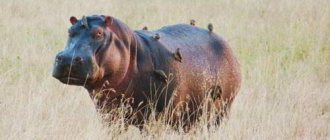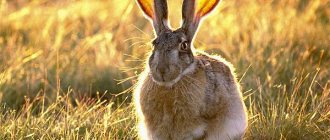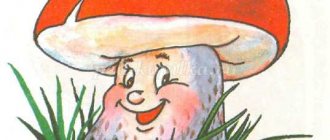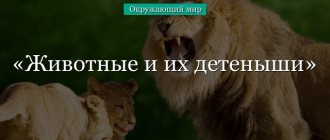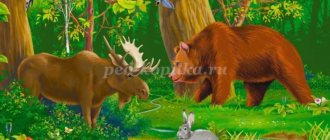Summary of a lesson in the senior group on speech development “Wild animals of Russian forests”
Lesson objectives:
- consolidate knowledge about the life of wild animals,
- develop word formation skills,
- cultivate interest in the natural world around us and a caring attitude towards animals.
Preliminary work: Conversation with children about the life of wild animals in their native land, looking at paintings depicting wild animals, d/game “Whose baby?”, d/game “Choose a word”, d/game “Whose tail, whose head?”, guessing riddles about wild animals, reading Russian folk tales about wild animals.
Progress of the lesson
Children enter the group and sit on chairs in a semicircle in front of the teacher, who is holding a telegram form in his hands.
Educator: - Children, we received a telegram from Znayka from Sunny City, he is going on a trip to the forest, and asks you to share your knowledge about wild animals. Are you willing to help?
Children: - Yes!
Educator: - To begin with, let's remember those who live in the Russian forest. Let's play the game "Fourth Wheel".
The goal of the game is to remove the extra word from the listed row.
- Boar, rabbit, fox, squirrel...(rabbit is a pet),
- Hare, wolf, hedgehog, polar bear...(the polar bear is a wild animal of the North),
- Lynx, elk, brown bear, kangaroo... (kangaroo is a wild animal of Australia).
Well, we have decided on the animals, and now we will name as many words as possible, describing each of the inhabitants.
Didactic game “Which one?” Which? »
Wolf (Which?) - angry, hungry, gray Bear (Which?) - big, strong, brown Fox (Which?) - cunning, cautious, red Hare (Which?) - cowardly, small, gray, white Squirrel (Which?) ) – thrifty, nimble.
Outdoor game “Who moves how?”
Children are asked to move around imitating the movements of wild animals, and the presenter is invited to guess who exactly the children showed.
Educator: - We told Znayka who they are and what they are like, the forest inhabitants, and now we’ll tell you which of them lives where.
Didactic game “Who lives where?”
- In the hollow lives...(squirrel), - In the den lives... (wolf), - Under the bush trembles... (hare), - In winter in the den.... (bear), - In the hole... (fox), - In the hut under water …(beaver).
And now is the time to tell who eats what.
Didactic game “Who eats what?”
Guys, before you answer this, you should remember which of the animals are herbivores.
Children: - Herbivores: hare (grass, tree bark), squirrel (nuts, mushrooms), elk (grass, tree bark, branches, hay).
— Predators: bear (honey, berries, carrion, fish), wolf (hares, sheep, calves), fox (chickens, geese, hares, mice), lynx (animal meat).
Educator: - Well done, that's right! Now the game is a joke. One morning the forest animals woke up and saw that their tails were all tangled. The animals were upset. Help the animals find their tails by answering the question “Whose tail is this?”
Didactic game “Whose tail is this?”
A hare has a fox's tail - he (fox) A wolf has a hare's tail - he (hare) A bear has a squirrel's tail - he (squirrel) A hare has a bear's tail - he (bear) Now all the animals have found their tails!
Thank you, children, you helped Znayka a lot! He is grateful for your help!
Application:
Turlevskaya Oksana Anatolyevna, teacher of the MADOU No. 1 “Alyonushka”, Asino, Tomsk region, Russia.
The material is published in the author's edition
Summary of the educational lesson “Wild Animals” in the middle group
Educator: Now we will check whether you named the wild animals correctly, and the wise owl will help us with this. She has prepared riddles and a story about animals for you. A red-haired little animal, jumping and galloping through the trees. He lives not on the ground, but on a tree in a hollow. 3 slide.
Squirrel is smart and agile.
The forest dweller forms her nest from twigs, moss, and lines the inside with wool and feathers. To make it softer and warmer. It feeds on plant foods - mushrooms, berries, tree fruits, nuts, acorns. 4 slide.
In summer he walks without a road, near pines and birches, and in winter he sleeps in a den, hiding his nose from the frost.
5 slide.
The bear is a formidable forest dweller.
His legs are thick, his head is massive with small ears and eyes, his coat color is brown. Swims well and climbs trees. The bear is a predator, but loves berries, honey, fruits, grains, grass, and plant roots. In winter, the bear sleeps in a den. 6 slide.
He is afraid of everyone in the forest: the wolf, the eagle owl, the fox.
Runs from them, escaping, With long ears... 7 slide.
The hare is a wild animal.
His ears are long, his tail is not large, and his hind legs are strong. In summer the hare is gray, in winter it is white. The hare has more than enough enemies. Wolves, foxes, birds of prey, he is afraid of them all. But catching up and catching a hare is not easy. It feeds on grass, branches, tree bark, clover, mouse peas, mushrooms, and blueberries. 8 slide.
I live in a pack in the forest, I bring fear to all the little animals.
A menacing sudden click of teeth! I am a fierce gray... Slide 9.
The wolf is a forest dweller, a large animal that looks like a dog.
The wolf is quite smart - he always deftly avoids danger, and is skilled in hunting. In the forest, the prey of wolves is elk, roe deer, wild boar, and deer. They can sweep away everything in their path - eat a hare, a bird, a bird's egg. If they come across a herd of sheep, they will kill them all. 10 slide.
The fluffy tail takes care of the animals.
They know the redhead in the forest is very cunning... Slide 11.
The fox is a cunning cheat.
She has a gorgeous red coat and a long fluffy tail with a white spot at the end. This animal's hearing is excellent. In winter, the fox listens carefully to various sounds and accurately determines where the mouse is fiddling around under the snow. In the summer, the fox feasts on frogs, small birds, and animals. Loves to carry hens and cockerels. 12 slide.
Instead of a fur coat there are only needles.
Wolves are not afraid of him either. A sharp ball, no legs visible, Call him of course... Slide 13.
The hedgehog is one of the most famous forest inhabitants.
The entire body of the hedgehog is covered with needles (except for the abdomen, furry muzzle and fluffy paws). His eyes are like two black shiny beads. He doesn't see well. A hedgehog's nose is always wet. Feeds on insects, snakes, toads, frogs, snails, mice, snakes, strawberries, raspberries. The hedgehog sleeps in its nest all winter. Slide 14
A wild animal runs along a path, then grunts and squeals.
With him is a caravan of children, This forest beast is... slide 15.
The wild boar is the closest relative of the domestic pig.
Adult male boars grow terrifying fangs that are dangerous for any animal. Boars run quite quickly and move well through dense thickets. Their body is covered with stiff bristles that do not cling even to gnarled branches. Boars are omnivores. They feed on rhizomes and tubers, seeds and fruits of trees, mushrooms, moss, and also eat food of animal origin: earthworms, beetles and their larvae, fish, mice. 16 slide.
The horns are heavy in weight, He walks importantly through the forest: He is the owner, not the guest - Gloomy and angry...
17 slide.
Elk is a large animal.
He is easily recognizable. Large, powerful legs, his upper lip is very large. The neck is short, the ears are long, pointed, and the withers are high. Adult moose boast large, shovel-like antlers. But sometimes the elk get tired of the antlers. And he sheds them in November-December and walks without them until May. It feeds on branches of trees and shrubs, plants, sedges, and marsh vegetation. Educator: So what are these animals called? Children: These are wild animals. Educator: Oh, trouble! Our animals were bewitched by an evil sorceress, and they forgot what they eat. What do we do? (children's answers) Can you help them remember? Game “Who eats what?”
